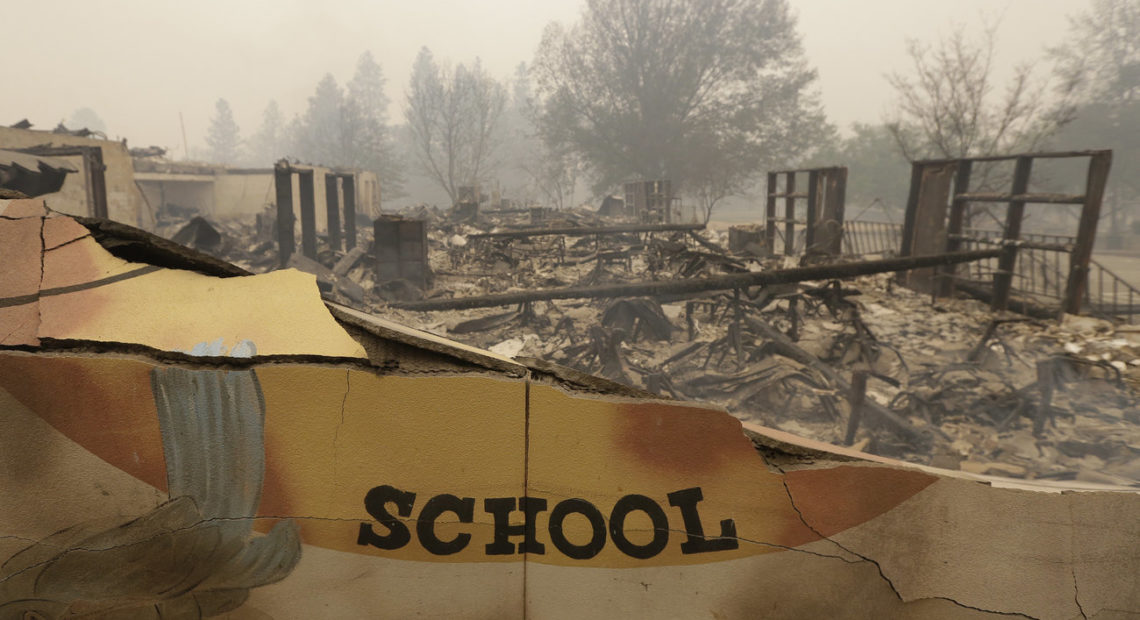
A Personal And Harrowing Account Of How The Camp Fire Devastated Paradise
Read On
BY PAUL WEINGARTNER
NOTE: The Camp Fire tore through Paradise, Calif., the morning of Nov. 8, 2018. At least 48 people have been confirmed killed at the time of publication, with more still missing. What follows is a personal account of Paul Weingartner, formerly of Moscow, Idaho, who is a nurse at Adventist Health Feather River in Paradise. Some details may be disturbing.
I was at work in the emergency department at Adventist Health Feather River hospital on the morning of the fire. Those of us who arrived at 6:45 a.m. to start our shift noticed the initial plume of dark smoke rising over Feather River canyon. Due to extremely dry conditions and high winds, and the fact that the hospital sits on the edge of the canyon, we immediately activated our Incident Command Center and prepared for an evacuation of the hospital.
All patients had to come through the emergency department: patients in wheelchairs awaiting scheduled surgeries, an intubated ICU patient and other critical patients in hospital beds, a brand new mother after a cesarean birth, and several newborns from the Birthplace Center, etc. Evacuation was completed via private vehicle, ambulance, and law enforcement vehicle by about 8:30 a.m. as the fire glowed and thick black smoke began to hover over the hospital. At 8:45, officials strongly recommended that hospital employees evacuate as well.
By this time, Feather Canyon clinic, the “old” hospital between the canyon and the new hospital, was on fire, as were several other outbuildings — education, human resources, physical plant — and the open grass areas around the helipad and adjacent to the parking lot were burning.
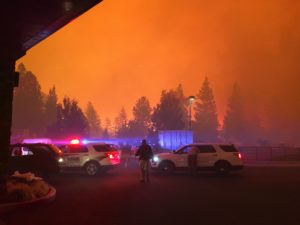
Emergency crews coming to assist in the evacuation. Photo courtesy of Paul Weingartner
Embers the sizes of small stones were dropping on the cars lined up to leave the parking lot.
By the time I pulled out, the road we were instructed to take away from the hospital was impassable due to the high traffic volume of the general evacuation, and I was abruptly re-routed in the opposite direction. This put me on my normal route away from the hospital and was mostly free of traffic. I felt relatively safe.
This was a short-lived feeling, however. The crossroad that would take me over to the main highway back to Chico is a road that dips down into a deep gully. The land and homes on the passenger side of the car were already burning, and the smoke had created the profound darkness of night. As I got to the bottom of the ravine, I was in a line of cars that slowed to a near standstill.
Soon the fire jumped the road, and I found myself at a standstill in between 60 to 70-foot-high evergreens in flames. Embers and debris were dropping everywhere, and the smoke and heat made it difficult to breath. The wind sounded like the exhaust of a jet engine, and the car was buffeted steadily. Drivers began to move slowly from roadside to roadside to avoid flare ups, and we began using both lanes, fearing (I presume) that we would not be able to get out of the gully before it was completely engulfed.
I began to realize that I might not make it out, that I would be burned in my car or, my worst fear, suffocated. I had no cell service in the ravine, and I couldn’t call my family to say goodbye.
As these thoughts were coming into my head, and I was trying to resign myself to a stupid death, the side door burst open and a guy jumped into the passenger seat. I recognized him immediately as Josh, a hospital employee. He quickly explained that his car, several vehicles behind mine, had stalled and caught fire and he had to abandon it. It was too hot to run in that heat.
We made our way, inch by inch, up the road out of the ravine. A driver in a VW Bug in front of us kept stalling and finally got out of her car and into a truck next to her.
Then she got out, reached back into her car, and pulled out a small dog. She placed the dog in the truck, then reached again into her car and pulled out another small dog. At this time, flames are lapping at the rear of my car, and I am concerned the gas tank might explode. We had already heard several explosions, probably airbags, gas lines, propane tanks, etc. She placed the dog into the pickup, and once again climbed into her car.
All of this seemed to happen in silly slow motion. It only took a few seconds, seconds that felt like minutes turning into hours, before she pulled a very reluctant and large furry dog—looked about 80 or so pounds—out of the car, and hefted it up into the pickup. Then she finally climbed in herself. I went around her car when I could and, following the pickup, continued up the grade, in fits and starts, hoping I would not stall my own car.
The truck I was following went to the left around another pickup that had been abandoned but then had to stop. I skirted the abandoned truck on its passenger side, driving onto the hillside, through the fire, before pulling back in front of the truck. I noticed another pickup ahead and, to my left, in flames, its passenger door opened and a charred leg sticking out.
From behind me I heard the unmistakable sound of tractor treads and soon saw a bulldozer with a CalFire employee coming up from behind and pushing abandoned and burning cars off the road.
I followed the tractor to the top of the hill.
Once at the top, I was ordered by CalFire to follow several other vehicles to the left into a large field. I sheltered here with about a dozen other vehicles for about 5 minutes or so before we were instructed to return the way we came and head back to the hospital parking lot.
The road we had been traveling on toward the main highway was apparently blocked, and the main crossroad was engulfed. I did not want to go back into the ravine, but I followed directions, driving over burning tree limbs, downed power lines, and a road filled with embers.
At the bottom of the gully we passed Josh’s burning car and then made our way back up out of the ravine to the road that the hospital is on, passing burned-out, smoldering homes, and homes still in full-flame, ducking the fallen power lines.
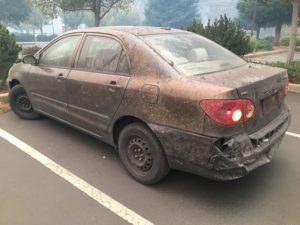
Paul Weingartner’s Toyota after evacuating away from Adventist Health Feather River hospital, only to be directed back to the hospital.
When we arrived at the hospital parking lot, I got out of the car to look at the damage. Modern cars melt. The headlights and taillights were shriveled, the rear bumper was melted, the front quarter panels were warped and the wheel-well linings rubbed the front tires. The formerly gray paint was now a brilliant burnt bronze, cracked and flaking off. The antenna atop the car was melted to the roof.
At the hospital we set up a makeshift ER in the parking lot, under the large canopy entrance. Dr. Peck, the ER physician of record that morning, tasked me with being the charge nurse. We had several other nurses available to help: Cassie, an ER nurse; Jeff, the nursing director of the surgical unit; Allen, the nursing director of ICU; Sarah, the nursing house supervisor; Eva, our vascular access nurse; and Nichole, a surgical department nurse who also worked in the ER, and a couple others. Several pharmacy staff members were helping as well, as was our ER unit secretary for the morning, Darren.
One ER nurse and a friend named Chelsea arrived hobbling. She apparently had had to abandon her car and hurt her foot while running from the fire. Later I learned she had broken her foot. I got a 3D walking boot out of our ortho supply, and we fitted her with that so she could walk around easier.
We pulled out gurneys from the smoke-filled ER rooms and carts of supplies and equipment.
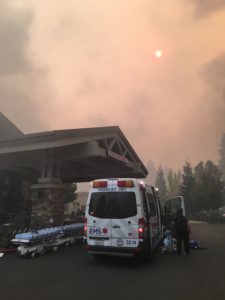
Smoke surrounds the Adventist Health Feather River hospital on the morning of the fire burning into Paradise, Nov. 8, 2018. Photo courtesy of Paul Weingartner
Someone went to the cafeteria and brought back flats of bottled water and carts of fruit, snacks, granola bars and candy. Most of the people who came — some by private vehicles, others by law enforcement vehicles and ambulance — were people who needed warmth and oxygen. We set up a walking-wounded area and began passing out blankets and connecting people to O2 cylinders.
Two more serious patients arrived. One was the previously mentioned woman with the fresh cesarean section whose evacuation ambulance had caught fire. She was brought back by another ambulance. Her pain was treated, and I found out her new baby and husband were safely at Enloe Medical Center in Chico. Another patient was an elderly women with a reported stable brain bleed who was on palliative care. We got her out of the back seat of the SUV that had been tasked to evacuate her, placed her on a gurney, and treated her pain with morphine.
She died within the hour.
By now the rear section of the hospital was reportedly on fire. We decided to move everyone to the helipad, which is a large cement circle in the middle of a field behind the ER that had already burned. It took some time to move all the equipment and gurneys and patients down to the pad, but from there we watched as the rear portion of the hospital burned and sent thick black smoke into the air.
When we heard that a road out of the area had been cleared, we made plans to evacuate all of the patients once again, this time to Oroville, by law enforcement vehicle and ambulance. This took until about 1:30 p.m.
Once everyone was evacuated, and only law enforcement officers and firefighters stayed behind, I left to travel the same open road out of the area and back to Chico. It had only been about six or so hours since the fire had started, but most of Paradise was either burned out or still in flames.
As I drove, I saw burned-over lots and shells of homes and charred cars for miles from the hospital. Everything was either in flames or destroyed.
There are not sufficient words to describe the devastation I saw.
Paul Weingartner is a clinical faculty member for the School of Nursing at California State University, Chico. He is volunteering at the Red Cross evacuation shelter in Chico. Adventist Health announced that employees will be paid until February 5, 2019, with full benefits, retirement contributions and continued accumulation of paid-time off.
Copyright 2018 Northwest Public Broadcasting / nwpb.org
Related Stories:
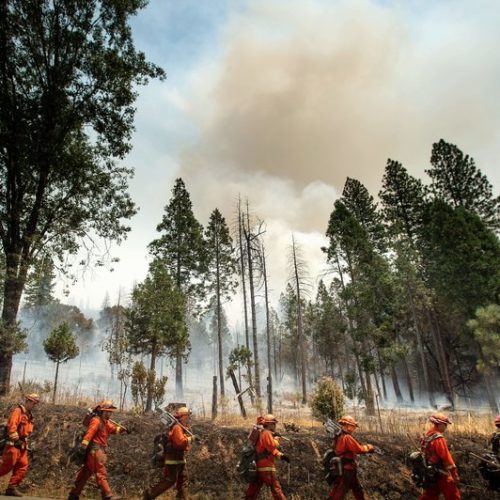
Serving Time, Dodging Tumbling Boulders, And Fighting Wildfires For $2 A Day
As flames consume parts of California, an unexpected group of firefighters has put their lives at risk to protect communities: prison inmates. For $2 per day — and another $1 an hour when battling fires — qualified inmates can volunteer to help authorities combat fires.
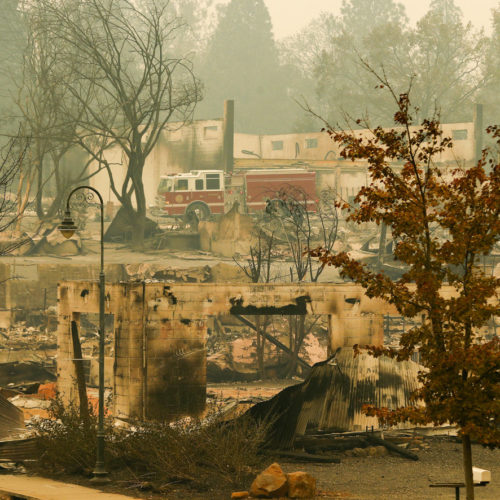
California Camp Fire: Confirmed Deaths Above 70 As Missing List Balloons Over 1,000
Authorities say at least 63 people died in the Northern California wildfire known as the Camp Fire, which has burned through at least 218 square miles of land and consumed the town of Paradise. Seven sets of remains were discovered on Thursday.
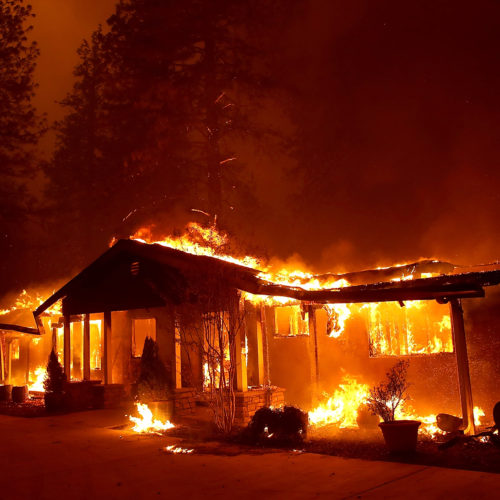
Paradise Lost: Northern California Town Destroyed By Fire, At Least 29 Dead, 6,000+ Structures Burned
The entire town of 27,000 people was evacuated in front of the wildfire in Northern California. The fire is the latest in a string of disastrous wildfires to hit the state in the past year.
















